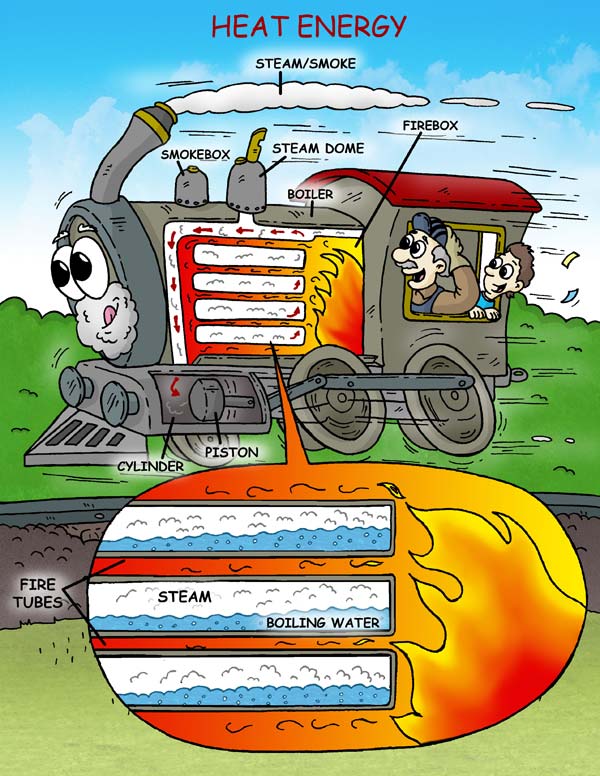Have you ever ridden a steam locomotive?
You can find a classic steam locomotive on old railways because it was traditionally used to transport both people and merchandise to various locations. Merchants use the steam locomotive to carry their goods and sell it in trade fairs or markets. Before the modern railroad system was introduced, all railways used a steam locomotive for their trains. You probably have wondered what makes a steam locomotive so fascinating, and that’s because it’s powered by a steam engine!
What is a steam engine?
A steam engine is the main reason why steam locomotives can function. With the steam engine people can travel faster which made trade more efficient. Steam engines are among the most brilliant discoveries by mankind. Although most steam locomotives are no longer operating on railways today, you can still find steam engines being used in various factories and industrial plants.
What powers a steam engine?
A steam engine is a type of machine that only relies on steam to facilitate energy. That’s right! Energy from a steam engine comes from the heat that emanates from the boiler, which works much like a huge pot filled with water. Burning coal to fire up the boiler is similar to turning on the stove to boil water in a kettle. Men continuously place coal to burn so that the heat can circulate within the boiler, and as the water continues to boil it releases steam which in turn makes the machine work. It looks so simple that it’s amazing how this can power an engine!

Understanding energy from steam engines
Like steam engines, everything uses energy to function. For example, food that we eat gets digested, and then converted into fuel that our body needs to perform our daily tasks. Energy can be used and converted, but can never disappear. It only passes from one state to another, and steam engines are the perfect example of seeing how it happens. For steam engines to work, energy is derived from four different kinds: chemical energy, heat energy, kinetic energy and then finally, potential energy.
- Chemical energy. To produce steam which a steam engine uses to operate, coal is loaded onto the firebox, which is essentially like an oven or wooden stove. Because coal is fuel which can transmit heat efficiently, it is used to increase the temperature for the boiler. The moment coal touches the fire and bursts into flame, it combusts. This kind of chemical reaction is called chemical energy.
- Heat energy. The conversion of energy begins in the firebox and ends in the boiler. In a steam engine, chemical energy is transformed to produce heat energy after the coals are set on fire. Heat energy is directed by a change in the temperature. Right after the coals ignites, that chemical energy gets converted to heat energy, which is used to boil the water and produce steam.

- Kinetic energy. With steam, the engine can now use this energy to force motion into the gears or in a case of a steam locomotive, the wheels. The steam forces the cylinder and piston within the steam engine to shuffle and move, initiating the turning of the wheels and putting it in motion. This is called kinetic energy. Kinetic energy derived from heat energy (steam) gives power to the cylinder and piston to act forward and backward, triggering mechanical action towards the wheels.
- Potential energy. Lastly, steam engines have potential energy when there is a need to function through a gravitational pull. When a steam locomotive goes up a hill, the kinetic energy that generates movement of the wheels suddenly becomes potential energy before the locomotive goes downhill. As the locomotive travels down the hill, this same potential energy converts back to kinetic energy, helping to bring the locomotive down.
Simply put, steam engines use fire and coal (chemical energy) to boil water and produce steam (heat energy), which in turn pushes the cylinder and piston to drive the movement of the wheels (kinetic). As the wheels turn and move towards a slope or a hill carrying a load (potential energy), it can also go faster when it goes downhill (kinetic energy). This gradual yet steady shift of energy forms makes it possible for a machine like the steam engine to work! Now that you understand that steam engines use energy in various forms to work, don’t you think it’s also important to conserve energy? Without energy, nothing can function properly, and everything including steam engines will not operate as it should be.
Resources
- Steam Engines Explained In this book, Stan Yorke explains the history of the steam engine and the enormous variety of uses to which it was put. There are over 50 photographs, plus detailed diagrams..
- Wilesco 10 steam Engine D10 155 ml Boiler Contents, Including Safety Valve and Whistle-Pipe.
- Sunnytech Hot Air Stirling Engine Single Flywheel Education Toy Electricity Power Generator.
- Playz Train Steam Engine Model Kit to Build for Kids with Real Steam STEM Science Kits for Kids, Model Engine Kits for Adults and Educational Hobby Gift.
